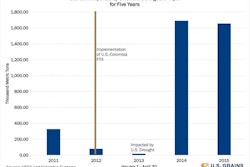In the overnight session the grains were mixed with corn up 2 1/2 cents soybeans down 1/2 a cent and wheat down 1 1/2 cents. The U.S. dollar is mostly unchanged with crude oil 74 cents higher. Rains are likely to continue in the southern plains over the next few days and then a drying trend is likely to take hold for the first part of June.
Yesterday, the weekly ethanol production numbers showed an increase in production by 11,000 barrels per day to 969,000 barrels per day. Stocks declined this week by 337,000 barrels to 20.1 million barrels. Ethanol production has picked up sharply in the late part of May which is typical going into the driving season. Ethanol production is up 4.8 percent over last year compared to the USDA’s corn used for ethanol balance sheet item which suggests only a 1.3 percent increase.
Export sales were mostly in line with expectations for old crop sales, but new crop corn and soybean sales disappointed. Old crop soybean sales beat analyst expectations at 322,400 metric tons which was up sharply from last week’s sales of 98,909 metric tons. The buyers this week included China, the Netherlands, Germany, Japan and others. Soybean sales continue to show above average export demand late in the marketing year. However, this morning the Argentine soy crushers union stated that he expects a salary agreement which would end the strike that has negatively affected the local market and slowed exports form the Rosario Region.
Old crop corn and wheat sales met expectations with corn showing sales of 654,600 metric tons of old crop and wheat recording 42,500 metric tons. Sales were down 19 percent and 43 percent respectively but managed to fall within the range of expectations.
On Thursday GASC purchased 240,000 metric tons of which 75 percent was sourced from Russia and 25 percent was sourced from Romania.
Russia has taken measures to limit exports in the event of a sharp decline in the Rouble by setting a wheat export tax at 50 percent minus 5,500 Roubles per metric ton. The government set a minimum tax at 50 Roubles per ton. The export tax was designed to limit wheat exports in the event wheat prices reached 13,000 Roubles.



















